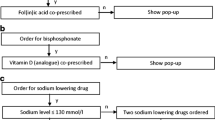Abstract
Introduction: Electronic decision support can reduce medication errors, and dose-range checking is one element of that support.
Objective: The aim of this study was to design an approach to setting upper dose warning limits in electronic prescribing systems where there are historical data on dosing.
Method: We used historical data on 56 drug-form combinations for which over 100 prescriptions had been issued between 1 June 2009 and 31 May 2010 in a bespoke electronic prescribing system at University Hospital Birmingham, UK. First, two experts derived dose limits for each drug-form combination, then the drugs were randomly divided into a training set and a test set. A variation of the ‘Nearest Rank’ approach to estimate statistical limits was used to derive the percentile with the optimal sensitivity and specificity.
Results: For the 28 drug-form combinations in the test set, the 86th percentile of dose gave a mean sensitivity of 95.3% and a mean specificity of 97.9% for warning limits, representing the highest reasonable dose; the 96th percentile gave a mean sensitivity of 90.2% and mean specificity of 99.5% for disallow limits, beyond which no dose should be prescribed.
Conclusions: Dosing decision support within electronic prescribing systems can be derived by statistical analysis of historical prescription data. We advocate a combined theoretical and statistical derivation of dose checking rules in order to ensure that prescribers are alerted appropriately to potentially toxic doses.






Similar content being viewed by others
References
Kaushal R, Shojania KG, Bates DW. Effects of computerized physician order entry and clinical decision support systems on medication safety: a systematic review. Arch Intern Med 2003 Jun 23; 163 (12): 1409–16
Ferner RE, Coleman JJ. An Algorithm for integrating contraindications into electronic prescribing decision support. Drug Saf 2010; 33 (12): 1089–96
Carey RG. Improving healthcare with control charts: basic and advanced SPC methods and case studies. Milwaukee (WI): ASQ Quality Press, 2003
Tennant R, Mohammed MA, Coleman JJ, et al. Monitoring patients using control charts: a systematic review. Int J Qual Health Care 2007 Aug; 19 (4): 187–94
Coleman JJ, Hemming K, Nightingale PG, et al. Can an electronic prescribing system detect doctors who are more likely to make a serious prescribing error? J R Soc Med 2011 May; 104 (5): 208–18
ABPI eMedicines Compendium, Datapharm Communications Ltd [online]. Available from URL: http://www.emc.medicines.org.uk [Accessed 2011 May 25]
BMA/RPS. British national formulary. 60th ed. London: Royal Pharmaceutical Society Publishing, BMJ Publishing Group, 2010 Sep
Gravetter FJ, Wallnau LB. Statistics for the behavioral sciences. 8th ed. Belmont (CA): Wadsworth Cengage Learning, 2009
Kuperman GJ, Reichley RM, Bailey TC. Using commercial knowledge bases for clinical decision support: opportunities, hurdles, and recommendations. J Am Med Inform Assoc 2006 Jul-Aug; 13 (4): 369–71
Acknowledgements
We would like to thank Dr Peter G. Nightingale for providing independent statistical support.
This work was funded by the National Institute for Health Research (NIHR) through the Collaborations for Leadership in Applied Health Research and Care for Birmingham and Black Country (CLAHRC-BBC) programme.
The views expressed in this publication are not necessarily those of the NIHR, the Department of Health, National Health Service Partner Trusts, the University of Birmingham or the CLAHRC-BBC Theme 9 Management/Steering Group. All authors declare no conflicts of interest that are directly relevant to the content of this study.
Author information
Authors and Affiliations
Corresponding author
Rights and permissions
About this article
Cite this article
Coleman, J.J., Hodson, J. & Ferner, R.E. Deriving Dose Limits for Warnings in Electronic Prescribing Systems. Drug Saf 35, 291–298 (2012). https://doi.org/10.2165/11594810-000000000-00000
Published:
Issue Date:
DOI: https://doi.org/10.2165/11594810-000000000-00000




